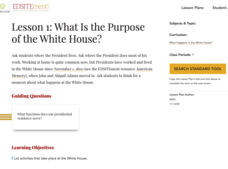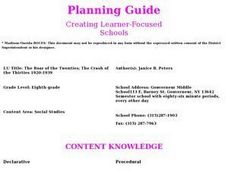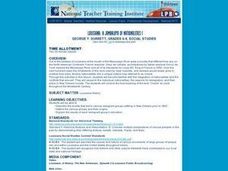National Endowment for the Humanities
Lesson 1: What Is the Purpose of the White House?
Pupils view images of presidents working and living at the White House. They list activities that take place at the White House and discuss the many purposes of the building.
Curated OER
The Roar of the Twenties; The Crash of the Thirties
Eighth graders, after assuming identities of prominent figures from the 1920's and looking at slides and data from the era, relate, in diary form, the cultural, economic and political changes that happened in America between 1920 and 1939.
Curated OER
Hilary Clinton
In this Hillary Clinton worksheet, students read about the life of the politician, then complete a variety of comprehension activities. An answer key is included.
Curated OER
The Gettysburg Address
Students explore the implications of the Gettysburg Address. In this Civil War lesson, students read a handout regarding Gettysburg Address, analyze an excerpt of the speech, and complete the provided worksheet activities.
Curated OER
Louisiana: a Jambalaya of Nationalities
Students write letters of protest outlining the reasons why abolishment of the Code Noir was going to have an adverse affect on political tensions in Louisiana.
Curated OER
Slavery
Fifth graders examine the reasons for the Civil War. They identify and explain different social and political movements of the time period as well. They discuss the impact of the Civil War on the development of the United States.
Curated OER
Why Was the United States Filled With Self-Doubt at the End of the Carter Administration?
Students research the events of the 1960s and 1970s using the internet. In groups, they draw their own political cartoons about one of the events. They also write a summary about how one specific event of their choosing gave the United...
Curated OER
Lending a Helping Hand
Middle schoolers research the work of North American NGOs and select one to support with a financial contribution as a class. In this philanthropic research lesson plan, students consider the work of Benjamin Franklin, defining good...
Curated OER
History of Immigration From the 1850's to the Present
Eleventh graders study the history of immigration from 1850 to the present. In this American History instructional activity, 11th graders compare the 1924 and 1965 immigration acts and give a reasoned opinion on each. Students...
Curated OER
Interview with Meriwether Lewis
Learners ask questions and prepare responses to Meriwether Lewis and his expedition. In this journal instructional activity students present their questions to the class.
Curated OER
The First Ladies
High schoolers compare two First Ladies. In this American history lesson, students read speeches given by Barbara Bush and Hillary Rodham Clinton. High schoolers respond to questions about the speeches.
Curated OER
The Art of Nonviolence: Martin Luther King, Jr., Gandhi, and Concepts of Nonviolence in Indian Art
Students make connections between nonviolent ideals and art. In this visual arts lesson, students discuss the successes of the American Civil Rights Movement and discuss Gandhi's influence on the movement. Students then examine images of...
Curated OER
Verbs with Participles
In this verbs with participles activity, students fill in the blanks, write prepositions, choose the correct sentence, complete a crossword and more about verbs with participles. Students complete 4 activities.
Curated OER
Nicole Kidman's Biography
For this Nicole Kidman worksheet, students fill in the blanks with the correct words in her biography and find adjectives in the word search. Students complete 2 activities.
Alabama Department of Archives and History
Marketing a Bad Idea: Why So Many People Joined the Klan in the 1920s
How did the Klu Klux Klan manage to gain so many members during the 1920s? Class members examine Klan documents and promotional materials to gain an understanding of the propaganda techniques used to attract members.
Digital History
The New Nation
George Washington and the new nation of the United States of America faced many problems in their inaugural years. Use this worksheet as a straightforward approach to learning about the reasons the country was experiencing a lack of...
Benjamin Franklin Tercentenary
Classroom Constitutional Convention
Students investigate the eight phrases that comprise the Preamble to the U.S. Constitution to determine its principles and purpose. Their own Constitutional Convention is convened to craft a preamble for their school's governance.
Curated OER
The Story of Kwanzaa
Celebrate Kwanzaa with a game of Kalah, also known as Mankala or Owara. Using an egg carton and a set of beans, players take all of the beans out of one of his or her cups and move to the right, dropping one bean into each of the next...
Curated OER
The Cherokee: Trail Where They Cried
Students read the Trail of Tears about the Cherokee Nation removal and write a letter pretending they are the grandparent of a Cherokee child. In this Trail of Tears lesson plan, students understand the changing of boundaries.
Curated OER
The People of Kansas: Where did they come from and why did they come?
Students review census data to correlate to emigration in Kansas. In this Westward Expansion instructional activity, students analyze a painting and create definitions for emigration and discuss why people emigrate. Students read and...
Curated OER
Court Documents Related to Martin Luther King, Jr., and Memphis Sanitation Workers
Young scholars read about the civil rights movement in their textbooks. They engage in a whole-class discussion of how nonviolent direct action can be a powerful tool for bringing about social, economic, or political change.
Curated OER
The U.S. Recognition of the State of Israel
Students research the political aspects of the U.S. position in the Middle East, considering, for example, Truman's position in view of the 1948 presidential election. They examine a telegram sent by the Secretary of State, George C....
Curated OER
What is Migration
Students conduct individual research and participate in discussion be able to identify difference between forced and voluntary migration. They identify if push and pull factors are caused by political, social, economic, or environmental...
Curated OER
We the People
Learners show how the meaning of the Preamble is reflected in current American culture. They collect images and/or sounds from media sources that represent, symbolize, or explain each phrase in the Preamble and create a media...

























